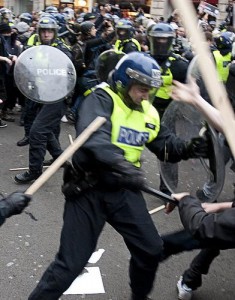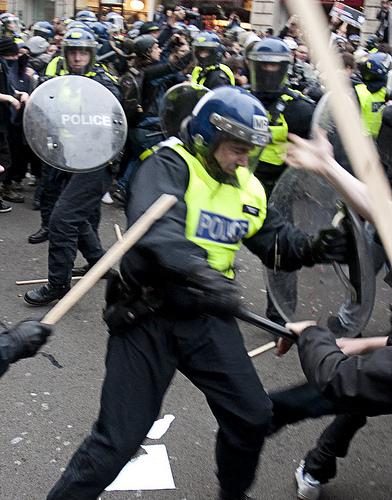
London riots; photo by Tomasz Iwaniec via Flickr
This depiction, however, flies in the face of evidence that many ‘rioters’ possessed no criminal background whatsoever. Nor did they all fall into one homogenous category. Those charged have ranged from schoolchildren to professional members of the work force. As one resident of Southall, west London, remarked, children as young as 12 were involved in the attacks in Ealing, and the rioters were also of diverse racial backgrounds: “They were black, white, Indian.”
Although some rioters sought to articulate particular grievances, denouncing discriminatory police searches and the elimination of Britain’s educational maintenance allowance, others have not attempted to justify their behavior, taking the chaos as an opportunity to steal from local businesses. Reflecting on the looting in Enfield, Labour councilor Chris Bond remarked that “it wasn’t anger that I saw, it was more like they thought it was all a big game.”
With homes and buildings vandalized, and communities literally reduced to ashes, it has become easy to dismiss the violence on the street as “pure criminality.” But such conclusions are naive and insufficient. Viral civil unrest should not be reduced to simple terms; the riots have many different elements. Although some rioters have been plainly motivated by opportunism, social, political, and racial factors are also at play. As journalist and blogger Laurie Penny has argued, few people know why the riots have occurred, and “…they don’t know, because they were not watching these communities [Tottenham, Edmonton, Brixton] Nobody has been watching Tottenham since the television cameras drifted away after… 1985.”
The latest violence clearly differs from the 1985 Broadwater Farm riots, when fierce racial tensions erupted following the death of Cynthia Jarrett, a local black woman who suffered a fatal stroke during a police raid on her home. But the current riots also have a racial element. The fatal shooting of Mark Duggan, a young black man, should be seen in the context of the Metropolitan Police’s longstanding record of discrimination against ethnic minorities. In 2009, a report by Liberal Democrat Lord Carlile, the independent reviewer of anti-terrorism laws, confirmed that police were seven times more likely to stop and search black and Asian youths in Britain than whites. The riots have occurred in some of the poorest boroughs of England, in communities where locals have every reason to doubt and despise the forces of law. According to a report by the Independent Police Complaints Commission (IPCC), since 1998, a total of 333 people have died in British police custody, and not a single officer has ever been successfully prosecuted. As journalist Nina Power writes, these figures make it strikingly clear why “the IPCC and the courts are seen by many, quite reasonably, to be protecting the police rather than the people.” In one NBC News report, a young Londoner was asked whether he believed that rioting was the correct way to express his anger: “Yes”, he replied. “You wouldn’t be talking to me now if we didn’t riot, would you? Two months ago we marched to Scotland Yard, more than 2,000 of us, all blacks, and it was peaceful and calm and you know what? Not a word in the press. Last night, a bit of rioting and looting and look around you.”
There is no all-encompassing meaning to the riots, but there are connections that can and should be made. As reporter Landon Thomas Jr. suggests, the riots indicate widespread resentment toward rising levels of youth unemployment. Currently, at least one million British citizens between the ages of 16 and 24 are officially unemployed. According to a 2010 report by the Paris-based Organization for Economic Cooperation and Development (OECD), the UK’s record for social mobility is worse than that of any other developed country. Taking a look at the mobility of earnings in 12 developed states, the OECD concluded that Britain showed the strongest link between individual and parental earnings: 50 percent of the economic advantage that high-earning fathers held over low-earning fathers passed to their sons. In Australia and Canada, by contrast, less than 20 percent of this wage advantage passed across generations.
The unrest also took place against a backdrop of brutal government spending cuts and enforced austerity measures. The boroughs that faced the worst looting and violence are among the most impoverished regions in the country. Hackney, for instance, is not only ranked as the most deprived borough in London, but also holds one of the highest national rates of child poverty, with 67 percent children in low-income families. Similarly, Haringey, the borough that includes Tottenham, suffers the fourth highest level of child poverty in London, as well as an unemployment rate of 8.8 percent – nearly double the national average. As the British comedian Russell Brand has commented in his surprisingly cogent and fluid article for The Guardian, “JD Sports is probably easier to desecrate if you can’t afford what’s in there and the few poorly paid jobs there are taken.” With fewer jobs, reduced educational allowance, and cuts to youth services, health, and legal aid, many rioters seem completely disconnected from their communities. Politicians would do well to heed the words of charities and workers, such as Camila Batmanghelidjh, who have spent decades aiding disenfranchised youth. Reflecting on the riots and those responsible for the looting, Batmanghelidjh writes: “Community, they would say, has nothing to offer them. Instead, for years they have experienced themselves cut adrift from civil society’s legitimate structures”
Yet more cuts are due to occur. Councils in London are preparing to slash their budgets by 24 percent over three years – that’s £5bn of cuts by 2014. According to a report by the BBC, this action will “see jobs go in 17 councils” and local services significantly reduced. As protests over UK cuts heated up last March, with protestors demonstrating across central London, the British government released a report, “advocating the provision of more than 300,000 apprenticeships for school leavers, and 15 hours a week of free pre-school education for underprivileged two-year olds. But the government does not show any interest in these strategies. Although many politicians, including the Conservative London mayor Boris Johnson, want to scrap plans to reduce police budgets by 20 percent, opposition to changes in spending cuts remains fierce. Chancellor of the Exchequer George Osborne has warned that any deviation from his deficit reduction strategy could “plunge Britain into the financial whirlpool of a sovereign debt crisis.” In the wake of the riots, Osborne continues to insist that it would be disastrous to relax the £81bn of spending cuts.
However, those attempting to address the riots and their underlying causes would do well to consider the words of sociologist Zygmunt Bauman: “social rights are indispensible to make political rights ‘real’, and keep them in operation.” The link between social inequality and the recent riotous violence cannot be ignored. In a country where the richest 10 percent are more than 100 times as wealthy as the poorest 10 percent of the population, the recent violence is by no means apolitical.

